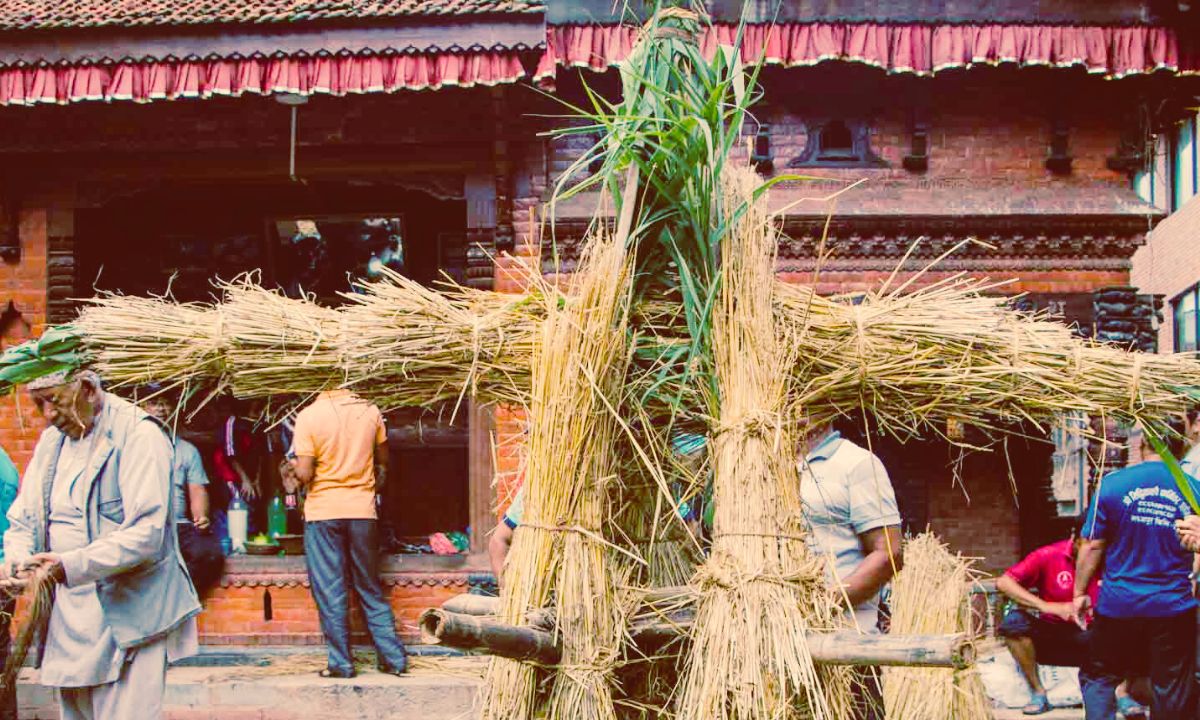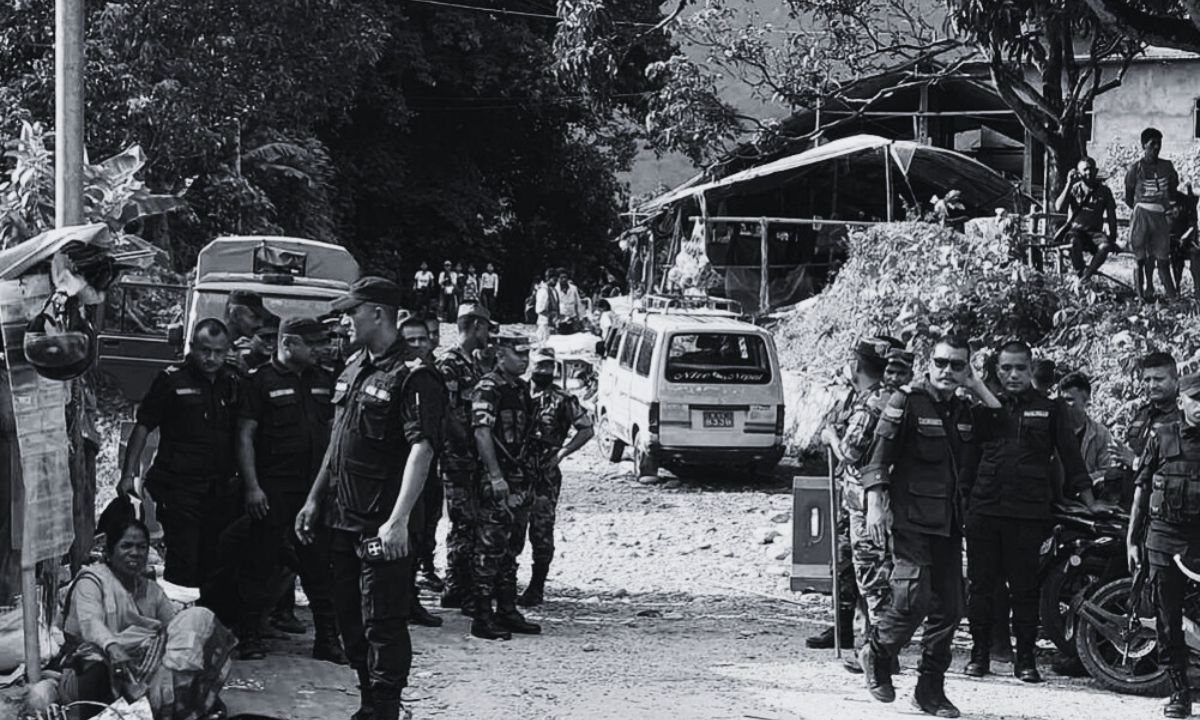Now Reading: Gathamuga Spirit Sweeps Kathmandu
- 01
Gathamuga Spirit Sweeps Kathmandu
Gathamuga Spirit Sweeps Kathmandu

As the monsoon rains drench the fertile lands, a unique Newar tradition blossoms in the bustling streets of Ason, Naradevi, Jaisidegal, and Maru. Today, Wednesday, July 22, 2025, marks Gathamuga, a vibrant festival where ancient myth meets communal cleansing, culminating in the dramatic burning of demon effigies. It’s a day when iron nails, black bangles, and the spirit of collective protection fill the air.
Markets Ablaze with Festive Spirit
From dawn, the traditional marketplaces are alive. Street vendors line every available space, their stalls laden with iron rings, sturdy nails, intricate henna designs, glossy black bangles, and various puja materials. Children, with a gleam in their eyes, dart through the crowds, their small hands clutching collected coins, eager to purchase the straw and bamboo that will soon transform into the fearsome Ghantakarna effigy. These creations, born of childish glee and communal effort, will later be paraded through the streets before their fiery demise.
Rooted in Myth and Monsoon’s Mysteries
Celebrated on Krishna Chaturdashi of the month of Shrawan, Gathamuga is more than just a festival; it’s a profound Newar ritual to banish malevolent spirits, purify homes, and re-establish spiritual safeguards. Its roots run deep, intertwining ancient mythology with the rhythm of agricultural life, forging a unique identity preserved through generations.
While its exact origins remain shrouded in the mists of time, historical evidence suggests the festival has been observed since the Lichhavi period. The very name “Gathamuga” speaks volumes: in Newar, ‘Ga’ signifies house, ‘Tha’ refers to pillars, and ‘Muga’ denotes strength, collectively emphasizing the vital importance of both spiritual and structural integrity within the home.
Centuries ago, the monsoon season consumed the Newar community with intense rice planting and fieldwork. Homes were often left unattended and accumulated a sense of neglect, believed to attract negative energies and provide sanctuary for evil spirits. Thus, Gathamuga emerged as a comprehensive communal cleansing—physical, mental, and spiritual.
The Legend of Ghantakarna: A Cacophony of Fear
At the heart of Gathamuga lies the terrifying tale of Ghantakarna, a monstrous demon who wreaked havoc, particularly on women and children, and disrupted sacred religious practices. His namesake came from the colossal 46-47 kilogram bell (ghanta) he wore in one ear (karna), whose deafening clang announced his fearful presence as he roamed villages, spreading terror and even devouring people.
Legend recounts that during one monsoon, an unusually loud chorus of croaking frogs began to overshadow the demon’s ominous bell. Enraged, Ghantakarna pursued the amphibians, only to drown when they plunged into the water, and he blindly followed. In enduring gratitude for their unwitting heroism, people still worship frogs on this day, honoring them for ridding the world of the terrifying demon.
Rituals of Renewal and Protection
For Ras Joshi, a respected culture expert and lecturer at Patan Multiple Campus, Gathamuga is far more than just a collection of myths and rituals. “The festival embodies a psychological cleansing,” he explains. “The act of creating and burning a demon effigy allows people to collectively release negative energies and reinforce a shared sense of protection and well-being.”
Joshi highlights the festival’s crucial role in marking a seasonal transition. “Monsoon was historically a time of vulnerability, disease spread, and a slump in productivity, with households often left neglected due to intense fieldwork. Gathamuga reconnects people with their households and reminds them of the importance of cleanliness for good health,” he states.
Throughout the day, Newar households undertake a thorough deep-cleaning. Effigies of Ghantakarna, crafted from straw, hay, and bamboo, are strategically placed at crossroads, symbolizing the expulsion of chaos from the community. Children, embodying unity and participation, go door-to-door, collecting donations to fund these symbolic creations.
Within homes, a small ‘puja’ is performed. A ‘makal’—an earthen pot filled with smoldering coal, purifying herbs, and three-headed nails—is lit to cleanse each room. As dusk descends, the ritual of ‘bau wayegu’ commences. Offerings of rice, raw meat, garlic, spices, and flowers are presented to spirits, intended to ward them away. A paper charm inscribed with mantras is then meticulously nailed above doorways, while three-headed iron nails are hammered into the main door, serving as formidable wards against evil.
“At night, we prepare the ‘bau’ with raw meat, garlic, and rice, and place it at the crossroads to offer it to the spirits,” shares Kiran Shrestha, a resident of Ason. “The ‘bau’ rituals are performed by the eldest male member of the family. He must carry the ‘bau’ to the crossroads barefoot and without speaking a word, and after placing it there, he should not turn back until reaching home. Additionally, we hammer iron nails at the entrance and hang protective charms. It’s said to keep evil spirits out.”
Finally, as the last rays of the sun fade, the demon effigies are dramatically dragged through the streets, their straw bodies igniting into towering flames. This powerful, final act symbolizes the destruction of evil, the casting away of disease, and the renewed strength and spiritual protection bestowed upon the community for the year ahead.
















